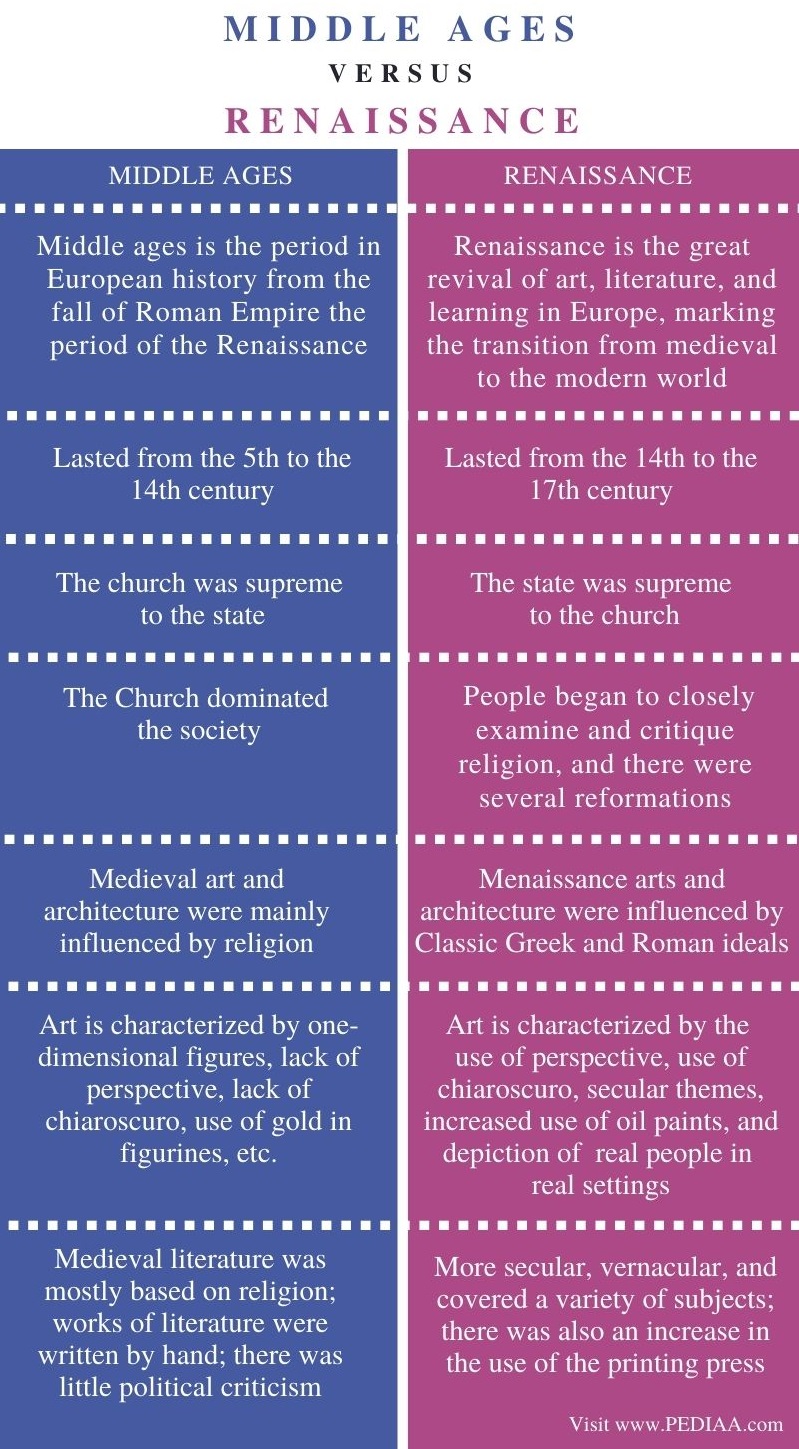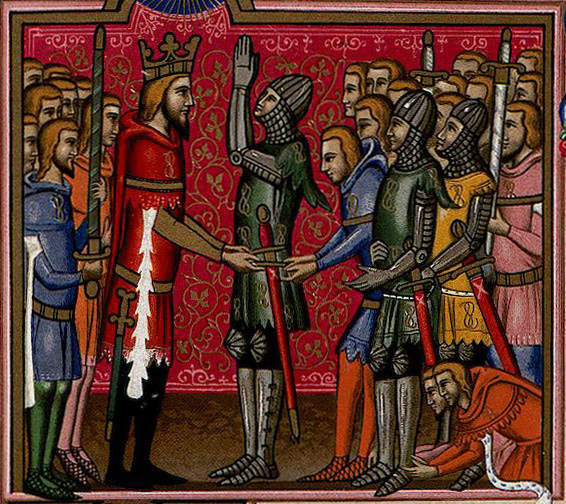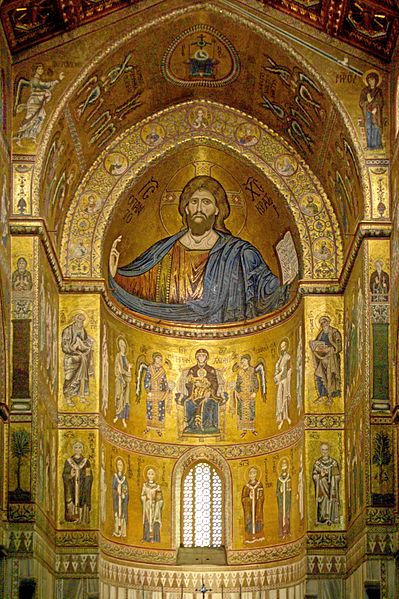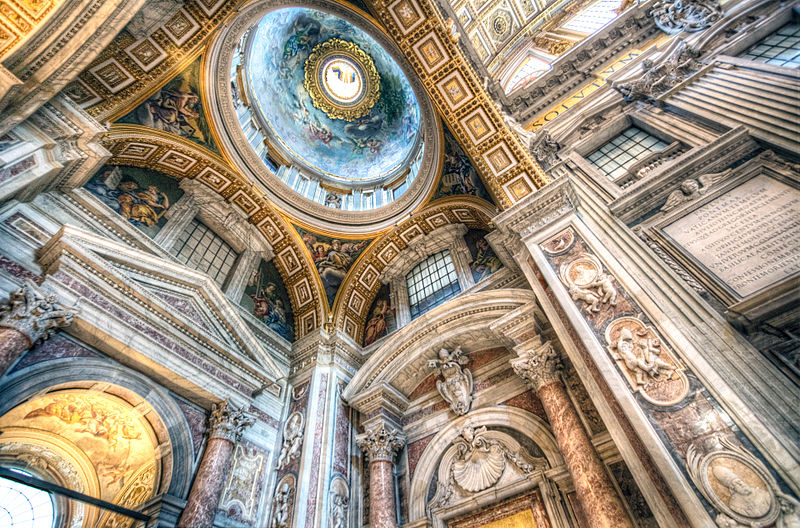Name at Least Three Differences Between Medieval and Renaissance Art
The main difference between middle ages and renaissance is that renaissance was the period of the not bad revival of art, literature, and learning in Europe, marker the transition from medieval to the modern globe.
There are three traditional divisions of Western history: classical artifact, medieval period/centre ages, and the modern menses. The centre ages catamenia began after the fall of the Roman Empire. Renaissance is the period that followed the middle ages. It is the bridge betwixt the Middle Ages and Modern history. Renaissance saw drastic changes and developments in many areas, such equally cultural, social, economic, and political.
Key Areas Covered
1. What is Eye Ages
– Definition, Society, Art and Architecture, Literature
2. What is Renaissance
– Definition, Art and Architecture, Literature
3. What is the Deviation Between Middle Ages and Renaissance
– Comparison of Fundamental Differences
Fundamental Terms
Medieval Era, Middle Ages, Renaissance
What is Eye Ages
Middles ages is also known as the medieval era. The middle ages of European history is between the fall of the Roman Empire and the beginning of the Renaissance. This menstruum lasted from the 5th to the late 14th century. This is the middle flow of the traditional divisions of Western history: classical antiquity, medieval period/middle ages, and the modern period. The medieval flow itself has three divisions: early, loftier and belatedly centre ages.
After the autumn of the Roman empire, the Catholic Church became the nigh powerful institution of that menstruation. In fact, the centre of medieval life is the Church. Kings and queens of this period derived power from the Church. The nobles and the Church-endemic most of the state and holding. The systems of bullwork and manorialism were pop during this era.
Medieval Social Structure
There were three distinct classes in medieval society: lords, vassals, and fiefs. The king (lord) owned all the land, and he gave out parcels of land nobles (vassals) who would promise loyalty and service to the king. The nobles, in turn, rented out their parcel of country to peasants (fiefs). However, before the male monarch granted land to someone, he had to make that person a vassal. This was done at a commendation anniversary that consisted of the 2-part act of homage and oath of fealty. During this, the king and vassal entered into a contract – the vassal promised to fight for the king at his command, while the rex agreed to protect the vassal from an external forcefulness.

Effigy i: Investiture of a Knight
Medieval Art and Compages
Medieval art and architecture consist of many styles, including early Christian and Byzantine, Anglo-Saxon and Viking, Carolingian, Insular, Ottonian, Romanesque, and Gothic. The fine art and architecture mainly centred around the Church building. Cathedrals were the largest buildings in medieval towns. Moreover, medieval fine art is an illustration of the passionate involvement and idealistic expression of the Christian faith.

Figure 2: Byzantine Monumental Church building Mosaics
Medieval Literature
Medieval literature was also based on religious. Death and resurrection, good and evil, and heaven and Earth were recurrent Christian themes in works of literature. The code of chivalry and courtly dear were also famous themes in medieval literature. Most of the early literature of the eye ages were also anonymous. Beowulf, Pearl Poet'south Pearl, Patience, Cleanness, and Sir Gawain and the Green Knight, John Gower's Confessio Amantis, Langland's Piers Plowman, and the works of Geoffrey Chaucer including Canterbury Tales are examples of medieval literature.
Most of the work used Christian themes such as death and resurrection, expert and evil, and sky and Globe. The lawmaking of knightly and courtly honey were also famous themes in medieval literature.
End of the Middle Ages
Between 1347 and 1350, the bubonic plague, which was so known as the "Black Death" killed thousands of people in Europe. xxx% of Europe's population died as a consequence of this disease. Middle ages was a period marked past wars, famines, and plagues. Hence, people also call it the "Dark Ages".
During the 11th century, feudal life began to change with the introduction of various agricultural innovations. Farming became efficient and productive and required only fewer subcontract. Consequently, more and more people moved to towns and cities. In the concurrently, the Crusades had expanded trade routes to the East, and there was a huge expansion in trade and commerce. By the 14th century, a new era called the Renaissance was born.
What is Renaissance
Renaissance that a period in the history of Europe that followed the Medieval flow. The Renaissance period ranges from the 14th to the 17th century and is deemed the bridge between the Middle Ages and Modern history. This menstruum saw drastic changes and developments in many areas, such as cultural, social, economic, and political. The name "Renaissance" comes from the French word which has the meaning "rebirth". Many people at that showed an interest in classical learning, especially the learning of Ancient Greece and Rome. For these people, Renaissance was the time of rebirth after the disorder and destruction of the middle ages. During the Renaissance, at that place were many famous artists, writers, philosophers, and geniuses.
Renaissance began in Italy, only information technology presently spread beyond the whole of Europe. Italian republic is the birthplace of the Renaissance since it was the centre of ancient Rome and Roman history and was a very rich land at the fourth dimension with wealthy patrons supporting many artists and geniuses.
Renaissance Art and Architecture
Renaissance was a gilt age for the arts and architecture. At that place are numerous art and architectural achievements that are still very famous today. Many exceptional artists and architects such every bit Donatello, Leonardo da Vinci, Michelangelo, Raphael, Sofonisba Anguissola, Filippo Brunelleschi, and Artemisia Gentileschi, and showed their uniqueness and creativity.
Renaissance architecture focused on symmetry, geometry, proportion, and the regularity of parts, following the style of classical antiquity. Palazzo Farnese, The Sistine Chapel, Basilica of St. Peter, and El Escorial are examples of renaissance architecture. Mona Lisa and The Concluding Supper by Da Vinci, The Nascency of Venus by Botticelli and The Creation of Adam by Michelangelo Buonarroti are some examples of renaissance paintings. Paintings of this era oftentimes used unnatural shapes, linear perspective, and depth perception.

Effigy 3: Inside of St Peter'southward Basilica
Renaissance Literature
The introduction of the printing printing led to the flourish of renaissance literature. Renaissance literature was mainly influenced by the ideas of Renaissance art, politics, and organized religion. It was also greatly influenced by Greek and Roman literature. Drama and poetry were the most popular forms of renaissance literature.
The renaissance writers explored religious and social themes in their work; the religious themes were frequently explored with a completely different approach than the medieval writers—for case, John Milton'south Paradise Lost and Christopher Marlowe's Md Faustus. Dante Alighieri, Giovanni Boccaccio, Miguel de Cervantes, Edmund Spenser, William Shakespeare, Sir Philip Sidney, Christopher Marlowe, John Donne and George Herbert are some notable figures in Renaissance literature.
Important Discoveries during Renaissance
Renaissance gave birth to many new ideas, cultures, religions, and means of life. It helped people change the way that they saw themselves and the world. Many people expressed their uniqueness and creativity through art, technology, science, and writing. Moreover, there were many scientific discoveries, mathematical advances, and theorems. Items similar the press press, guns, compasses, watches, and telescopes were invented during this catamenia. In addition to these, scientists and doctors besides discovered new data about the human being body and brought about many changes in the field of medicine.
Difference Between Middle Ages and Renaissance
Definition
Middle ages is the catamenia in European history from the fall of Roman Empire the period of the Renaissance while renaissance is the great revival of art, literature, and learning in Europe, marking the transition from medieval to the modern globe.
Time Menstruum
Middle ages lasted from the 5th to the 14th century while the renaissance period lasted from the 14th to the 17th century.
Faith
During the middle ages, the Church dominated the guild; the church was supreme to the state. In contrast, during the renaissance, the country was supreme to the church. Moreover, there were several reformations in the religion, and people began to closely examine and critique organized religion.
Art and Architecture
Medieval art and architecture were mainly influenced past organized religion, while renaissance arts and architecture were influenced past Classic Greek and Roman ideals. Medieval fine art is characterized by ane-dimensional figures, lack of perspective, lack of chiaroscuro, use of aureate in figurines, etc. while renaissance art is characterized by the use of perspective, use of chiaroscuro, secular themes, increased use of oil paints, and depiction of existent people in real settings.
Literature
Medieval literature was mostly based on organized religion; works of literature were written by hand; there was trivial political criticism. Renaissance literature was more secular, colloquial, and covered a multifariousness of subjects. There was also an increment in the use of the printing press.
Determination
When compared to middle ages, during renaissance in that location were drastic changes and developments in many areas, such every bit cultural, social, economic, and political. As its name suggests, information technology'south a period of revival fine art, literature, and learning. Thus, this is the principal difference between middle ages and renaissance.
Reference:
1. "Middle Ages." History.com, A&E Television Networks, 22 April. 2010, Available here.
2. "Overview of the Renaissance." Anglefire, Available here.
3. "Renaissance." History.com, A&E Television Networks, 4 April. 2018, Available hither.
Image Courtesy:
1. "Louis I of Naples – Order of the Knot" (Public Domain) via Eatables Wikimedia
two. "Monreale BW 2012-10-09 09-52-40" Past Berthold Werner – Own work (CC Past-SA 3.0) via Commons Wikimedia
iii. "Ceiling of St Peter'southward Basilica" By Anne Dirkse (www.annedirkse.com) – Own work (CC BY-SA 4.0) via Commons Wikimedia

robersonfortudieved96.blogspot.com
Source: https://pediaa.com/what-is-the-difference-between-middle-ages-and-renaissance/
0 Response to "Name at Least Three Differences Between Medieval and Renaissance Art"
Postar um comentário